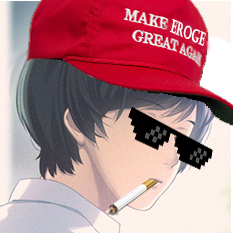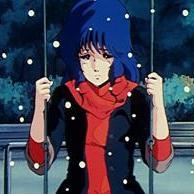-
Posts
378 -
Joined
-
Last visited
-
Days Won
3
Tyr last won the day on July 18 2017
Tyr had the most liked content!
About Tyr
- Birthday 03/14/1987
Profile Information
-
Gender
Male
-
Location
Gamindustri
-
Interests
Eroge, J-RPGs, Japanese entertainment in general
Otaku Web
-
Visual Novel Database (VNDB)
7887
-
My Anime List (MAL)
Tyrosyn
Contact
-
Skype
tyrosyn
Tyr's Achievements

Fuwa Veteran (5/11)
347
Reputation
-
 Tyr reacted to a post in a topic:
How to make a baby in Visual Novel ?
Tyr reacted to a post in a topic:
How to make a baby in Visual Novel ?
-
 Tyr reacted to a blog entry:
VN of the Month December 2003 - Saya no Uta
Tyr reacted to a blog entry:
VN of the Month December 2003 - Saya no Uta
-
 Tyr reacted to a post in a topic:
I'm leaving Fuwanovel, because I'm starting to realize that this community and the VN community at large has hurt me.
Tyr reacted to a post in a topic:
I'm leaving Fuwanovel, because I'm starting to realize that this community and the VN community at large has hurt me.
-
 Ramaladni reacted to a post in a topic:
What are you reading? Untranslated edition
Ramaladni reacted to a post in a topic:
What are you reading? Untranslated edition
-
 Ramaladni reacted to a post in a topic:
tales of berseria question
Ramaladni reacted to a post in a topic:
tales of berseria question
-
 Ramaladni reacted to a post in a topic:
tales of berseria question
Ramaladni reacted to a post in a topic:
tales of berseria question
-
 Ramaladni reacted to a post in a topic:
Certain Moment in Chris's Route in Maji De Watashi Ni Koi Shinisai
Ramaladni reacted to a post in a topic:
Certain Moment in Chris's Route in Maji De Watashi Ni Koi Shinisai
-
 Ramaladni reacted to a post in a topic:
Fuwanovel Confessions
Ramaladni reacted to a post in a topic:
Fuwanovel Confessions
-
 Tyr reacted to a post in a topic:
[project] Sakura no Kisetsu Ren'py remake project
Tyr reacted to a post in a topic:
[project] Sakura no Kisetsu Ren'py remake project
-
 Tyr reacted to a post in a topic:
The VN market and what can we learn from Yuzusoft, Hyperdimenional Neptunia and Nekopara
Tyr reacted to a post in a topic:
The VN market and what can we learn from Yuzusoft, Hyperdimenional Neptunia and Nekopara
-
 Ramaladni reacted to a post in a topic:
I found out that I like old VNs - that's just perfect style for me
Ramaladni reacted to a post in a topic:
I found out that I like old VNs - that's just perfect style for me
-
 Tyr reacted to a comment on a blog entry:
Fuukan no Grasesta: gameplay as of Chapter 6
Tyr reacted to a comment on a blog entry:
Fuukan no Grasesta: gameplay as of Chapter 6
-
 Tyr reacted to a comment on a blog entry:
The Lack of Choices in Swan Song and Why I Prefer VNs with Many Choices
Tyr reacted to a comment on a blog entry:
The Lack of Choices in Swan Song and Why I Prefer VNs with Many Choices
-
 Ramaladni reacted to a blog entry:
My favorite eroge of 2016
Ramaladni reacted to a blog entry:
My favorite eroge of 2016
-
 Tyr reacted to a post in a topic:
VNDB should include information about localization staff.
Tyr reacted to a post in a topic:
VNDB should include information about localization staff.
-
 Tyr reacted to a blog entry:
Plk_Lesiak’s Shovelware Adventures: Yume Creations
Tyr reacted to a blog entry:
Plk_Lesiak’s Shovelware Adventures: Yume Creations
-
Erewhon is a full nukige. There is literally nothing to it but (good) hentai scenes. Minikui Mojika no Ko is in all essence the real "Clockup" eroge this month. It's not a kamige but it's still good and has many interesting themes and scenes that make it worthwhile.
-
 Ramaladni reacted to a post in a topic:
Donald Trump Megathread
Ramaladni reacted to a post in a topic:
Donald Trump Megathread
-
 Dergonu reacted to a post in a topic:
Looking for a game full of heroine deaths <3
Dergonu reacted to a post in a topic:
Looking for a game full of heroine deaths <3
-
Tyr started following Hajimete no Okaa-san - a misunderstood gem
-
Tyr started following Ramaladni's Gift
-
No you can't. "Auto Suppress Repetition" is not for suppressing endless loops. It's for repetition of single characters. In fact, you should never check this option because it's unreliable and there are better ways to clean single character repetition. For endless loop repetition, you have to use a text hooker who can do that. However, the hook in question (mono_string_to_UTF8) is a VNR-exclusive hook. That means, only VNR and ITHVNR have it. Since ITHVNR cannot suppress endless loops, simply hook the game with the original VNR and activate the endless loop suppression in the hook settings. That will solve the problem. You can't. The activated hooks will always spawn every thread they are using. Use another subcontext. You can't do that easily with ITHVNR though since the developer of ITHVNR decided to remove all options for manipulating hooks that were in the original ITH because most people wouldn't know how to use them anyway.
-
 Nandemonai reacted to a post in a topic:
How to Install and Run Untranslated Visual Novel Text Hooking Tools
Nandemonai reacted to a post in a topic:
How to Install and Run Untranslated Visual Novel Text Hooking Tools
-
Don't think that you can just use ITHVNR for every game now. I still use ITH mainly because it has more Windows API hooks that are necessary for older games or certain emulators, does not have outdated engine hooks that will crash your game and the debug options are life saviors when something does not work correctly and you have to manually fix it. However, it is true that ITHVNR has better compatibility with newer games. That's why most people use it. Just keep in mind that ITHVNR is not the end it all solution. In my personal experience, two out of three times when people asked me to help them with their hooking problems, the problem was that they didn't use ITH but ITHVNR.
-
I completed the game yesterday and gave it a 9.7/10. It's a masterpiece. Even if it's not to one's liking, I can't see how it can be in any way mediocre. The way the story is told, characters are developed and the gameplay is implemented is so unique, I have never seen anything like this in any other eroge I played. And I doubt I will.
-
This is a common trope in scifi novels. It's not like Kanno invented this theory. He simply used this as a means to make the story look more complex than it actually is by explaining pointless backstory in the end. Which is a practice that was common back then. Elle, which was also published by elf a few years earlier, also used an elaborate scifi infodump in its epilogue to make the game appear more complex and meaningful than it actually was. Incidentally, both games take place in a seemingly normal town where you spend most of the time trying to bed waifus while some mystery is going on in the background and at the end of the game you have a long epilogue that tries to explain everything with science fiction twists. I don't see how YU-NO is anything special. I don't think science fiction visual novel writers only played this one eroge. That's like saying Ever 17 was influenced by Elle because both games' twists are based on a misconception of when the story actually takes place. Instead of the more plausible explanation that these tropes are simply popular concepts scifi writers like to use. And were already using for decades in literature and cinema.
-
Being popular does not matter in any way if you want to make an interesting statement about a genre or medium. Popularity does not say anything about a work itself, just about the time and environment it was released in, and even then you can't really make educated guesses about the reasons for its popularity because it's hard to find trustworthy sources when everyone tries to infer success from quality post hoc. Popularity is poison for historic research because it's a catalyst for muddling the truth, especially if it is a field like video games where history is written by non-academics who write misinformed blog posts which later become sources for even more misinformed articles. This thread is a good example for this: I can name you a dozen pre-YU-NO VNs that influenced each other, formed the multiple route mystery genre and were the inspiration for YU-NO. But nobody cares about them, right? Because YU-NO is the one everybody remembers talks about. And because it is the only eroge from that era people even know, they are very quick to make outrageous statements to explain why it is the one that is still talked about today. Like the first reply in this thread ("YU-NO also created the Multiple Route Mystery genre") which is hilariously wrong since we talk about one of the last games of an era that was the golden age of mystery adventures where nearly every VN that wasn't a linear mystery adventure was a multiple route mystery adventure. How is it even possible to make such a grave mistake? Well, the poster probably read this false statement somewhere on the Internet where a number of misinformative reviews and comments about YU-NO exist, written by people who don't know anything about the time and context YU-NO was released in but want to make explanations why it's such a good game and why it's still talked about today. However, this is all baseless conjecture, essentially historical revisionism. I didn't say that popularity can't be an interesting topic to explore. But that wasn't what I was talking about. What I wrote in my last comment was that none of the aforementioned VNs are innovative. Their popularity can't be explained solely by their content since VNs like these already existed for years. OP asked for VNs that were important. However, being popular does not make something important (though it certainly can be both). But we should refrain from inferring importance from popularity. I'm not sure what you mean exactly. You are probably referring to me saying YU-NO is not particularly innovative, aren't you? As far as I see it, YU-NO implements two concepts; multi-branched intersecting routes in the first part and an isekai world in the second part. Both are things you can already see in Kanno Hiroyuki's earlier works and are not that uncommon in other vns from that time either. (I don't want to make a statement what was the "first", I don't believe I have the knowledge to do that.) However, it's not like the different routes are interfering with each other story-wise. As far as I remember it's nothing more than taking an item from one route to use it in another. The links between the second and first part of the game are not that different from what you can see in a time travel story. The multiverse stuff that comes up at the end of the story is not really more than background information and not part of the actual story while there are also a multitude of other VNs implementing some kind of space/time cop trope. The reason I said it's not that innovative is because I don't think YU-NO does anything "new". What it does however is taking every trope that was already there and blends it together in one big epos. I think the reason YU-NO is remembered today is that it's the culmination of everything Kanno did so far and he never really tried to surpass it afterwards. However, if we are looking outside of Kanno's oeuvre, we can find many other VNs that explored and expanded on the genre in a similar or even different fashion. If you mean multiverse theories as in "multiple routes that connect with each other" like in Higurashi, for example D.O.'s Zatsuon Ryouiki has a multiple route mystery where the protagonist can remember stuff from other routes. A few years after YU-NO, elf released Kawarazaki-ke no Ichizoku 2 which is based on the flowchart and multiple route mystery concept introduced in YU-NO but expands on it and tells a story where visiting multiple routes is essential for the protagonist and the reader and everything is deeply connected with each other and not just an alternative reality on its own. As far as I see it, YU-NO is an important link in the evolution of the genre, but I don't think it's a beginning or an end.
-
If I have learned anything from having played over a thousand VNs from the 80s till today, it's that pretty much everything that is written on the Internet about the history of VNs is wrong, even the articles written by Japanese people. For example, there is nothing particular innovative about Kanon, YU-NO, To heart or Higurashi. The only reason that these novels are always mentioned in the context of "being the first of something" is that they are popular. And because people like to simplify everything and want their favorite VNs to be very special, they are very quick to give out awards based on their feeling of "this must be something special because I haven't seen anything else like this" even thought these people don't have the expertise to be able to make these kinds of statements. This is especially dangerous with the younger generation which likes to generalize about the past since social media encourages them to enter discussions about their hobbies, but are too lazy and ignorant to actually do the research. And because people nowadays don't want to read articles and news based on truths but rather want to read something that simply confirms their narrow worldview, these lies and made-up facts are quickly going viral. And if everyone says it, it must be true. History is written by the popular VNs. Just as it is with anime, video games, movies, books etc.
-
Maeda didn't draw hentai mangas initially. His intent was not to draw intercourse. Look how he phrased his explanation: That is clearly not meant in the context of porn since, well, explicit sex is the whole reason for its existence. He talks about exploring the boundaries of non-porn mangas with softcore elements. In this context, a tentacle monster is of course not as sexual as a naked man. And provides more opportunities for drawing stimulating situations without using an actual sexual context. Remember that "tentacle rape" was invented for the anime adaptation of his work, it wasn't his intention in the beginning to go this route. A quote from Wikipedia: Also, when he speaks of censorship, he doesn't mean mosaics, he really means what is allowed to be published (in a non-porn magazine) and what not. If you apply his reasoning to actual hentai anime, the genre of tentacle porn and the fascination with tentacles (Maeda even admits in your quote, that he was probably subconsciously influenced by ukiyo-e), you're using it out of context.
-
That is an Internet myth that became popular because it provides simple answers for something most people can't understand, but it is actually not true. Censorship was very lax in the 80s. The reason for this is that home video anime was still a new medium and hentai as a genre wasn't yet as pornographic as it is today, so the creators didn't know yet how they should apply these censorship laws that initially were invented for 3DPD porn. Tentacles back then were uncensored, but so were also vulvas and other things without a pornographic context. That changed a few years later when hentai became mainstream and censorship was enforced vehemently. Not only needed human genitals to be censored, vaginal and phallic objects, like tentacles, had to be censored too. Tentacles being a workaround for censorship laws is therefore nonsensical. There were no need and when the need arose, tentacles too were victims of it. Also, littleshogun already provided a source showing that tentacles were part of Japanese erotography for a long time already, so tentacles becoming a "thing" in the 80s couldn't have been true anyway. That was for aesthetic reasons since mosaics are ugly. For some reasons the perception of this changed in the later 90s, but that has nothing to do with censorship either.
-
Here is the correct viewing order: Ginga Eiyuu Densetsu: Waga Yuku wa Hoshi no Taikai Prologue Movie. Introduces main characters and setting. After watching this, you will know if you want to spend the next weeks watching 110 episodes of this stuff. Ginga Eiyuu Densetsu: Aratanaru Tatakai no Overture This movie is a compilation of the first four episodes of the series. I recommend watching this instead of the first four episodes since it's better in every regard, better animation and new scenes make for a quite cinematic viewing experience. Ginga Eiyuu Densetsu (110 episodes OVA) You can skip the first four episodes if you watched Overture, but they are not completely redundant since there are some scenes which were not included in the movie. The first season (first 26 episodes) is by far the best, the second season is still good (till episode 52) but I was honestly disappointed by the rest. Your mileage may vary. However, it's still a masterpiece and a must watch for every fan of Japanese animation. Optional: Ginga Eiyuu Densetsu Gaiden Two seasons of side stories taking place chronological before even the first movie. You can watch the different arcs in any order you want, but I highly recommend you watch the majority of them during the first 26 episodes of the main series. It's the point in the series where these side stories are the most relevant and they might not get to you as much emotionally if you watch them much later or after you finished the main series.
-

VN of the Month January 1996 - Ryuuki Denshou Dragoon
Tyr commented on kivandopulus's blog entry in Vndbreview
I really like that you include PS1 visual novels. That's a pretty obscure part of the vn history. -
Sad to see no Ushinawareta Rakuen on your list. It's my favorite PC98 game and I really think it's an overlooked gem of its time. I never gave the Yuujuu Senki series a chance because I didn't like the English Windows remake. Maybe I really should check it out again if the later parts are so much better.
-
I like the evolution the Custom Mate series had. I'm not really a fan of "customizing" your waifu, but it seemed to me this series is more about exploring different types of heroines rather than just catering to the whims of the player. Which means the emphasis is more on the personality and less on the visuals... contrary to modern "Custom" heroine games. I played Custom Mate 2 a few days ago and while it is short, repetitive and a little bit nanpa-esque, I did enjoy seeing the same situations with different types of girls. I really want to play Custom Mate 3 someday. Seems to be quite "epic", conceptually.
-

Advice for pre-2012 games on Windows 8 and beyond
Tyr replied to Clephas's topic in Voluntary Tech Support
You open ITH in your virtual box, then you activate "clipboard sharing". TA or whatever you use, which runs on your Host OS, will get everything the ITH in the virtual box captures since it will be shared between Guest OS and Host OS. Simple solution and works flawlessly (as long as you use VirtualBox as your virtual machine). I use VirtualBox for every game prior to Windows 7 and never had a problem with it. It's really the best solution to play older games. I have a WinXP VM for nearly every game and a Japanese Win98SE VM for really, really old games that only work on this OS. You can't use ITH in Win95 or Win98, so if you want to hook them, you have to hook the VM itself. I doubt anyone wants to do it, so I wont go into it here, but it is possible. ^^ -
Thank you, I'm really glad that you guys like it! I have to disappoint you, it will not be Natsu no Kusari xD (that was what you thought, wasn't it? ) To be honest, I don't like writing about really great games because I always have the feeling that I couldn't do them justice. Or that people think I'm exaggerating when I talk about games I really like and then dismiss my opinion as fanboying. At the moment, my plan is to cover some obscure/good/strange games ranging from 1996 to 2005. I also play games prior to 1996 but I think @kivandopulus already covered them sufficiently. I might write something about Ushinawareta Rakuen because that game is at the moment my favorite PC98 game and definitely needs more love! Of course, if you are interested in what I think about any game I have completed regardless of the release year, you can always request it and I probably write about it next time. I'm probably more motivated when I know that there is some demand, heh. I'm also open for recommendations, I'm always on the search for more hidden gems. If I ever come back to Natsu no Kusari, it will probably be less of a review and more of an analysis. Maybe when I re-read it someday which I will definitely do. Exactly. I think retro games are more diverse and capable of freely expressing whatever the creator intended to do. Nowadays, it's not really possible anymore since the market became so specialized and the expectations of the audience so streamlined that you can't really make something really innovating anymore without risking to lose your fanbase. Your comment made me realize why I thought that Hajimari no Kisetsu feels so realistic. It's probably because none of the characters can be classified as some kind of archetype. I really can't call anyone of them Tsundere or Genki girl or whatever stereotype there is. They all have distinct personalities, but they can't be summarized by tropes. I guess that is also kind of rare in this medium. Keep up the good work, I'm always looking forward to your retro visual novel reviews.








